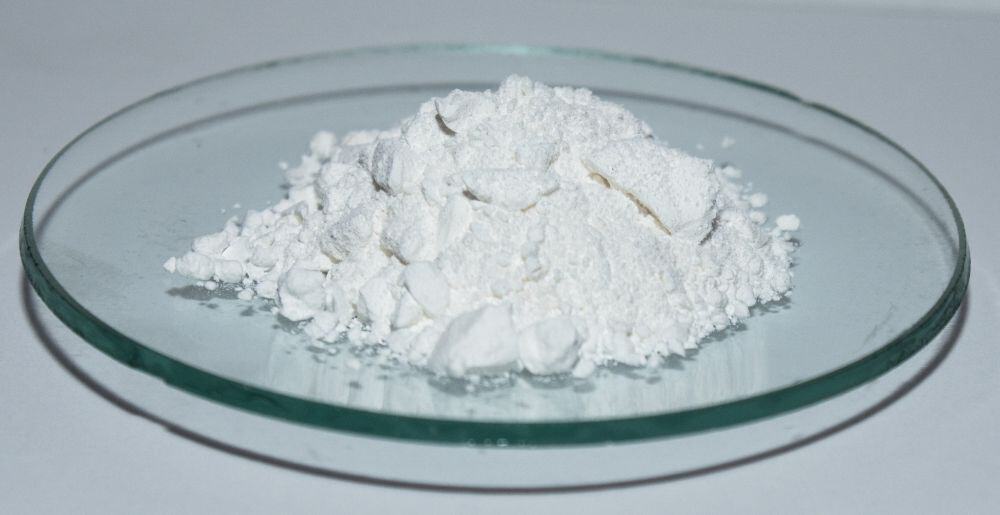
[Image above] A pile of magnesium oxide powder. Several oxides are routinely used as sintering aids in the fabrication of zirconia toughened alumina, but the effect of including multiple oxides at the same time is not well studied. Credit: Adam Rędzikowski, Wikimedia (CC BY-SA 4.0)
Even though sintering is a tried-and-true method for fabricating ceramics, it doesn’t mean the process is easy. The high chemical and thermal stability of ceramic materials can make it difficult to achieve proper densification of the starting powder, leading to deformation, cracking, and abnormal grain growth.
To make ceramic powders more amenable to heat treatment, sintering aids are sometimes added to the powder before heating takes place. Sintering aids are functional additives or dopants that usually help reduce the sintering temperature and encourage other mechanisms that support densification, such as introducing dislocations and enhancing particle diffusion.
There are several oxides that are routinely used as sintering aids in the fabrication of zirconia toughened alumina (ZTA), a high-performance ceramic composite that is desired for its combination of high hardness, strength, wear, and corrosion resistance. For example,
- Titanium dioxide (TiO2): When enough TiO2 is added to the starting powder, it can form an Al2TiO5 phase with the alumina during sintering, which impedes crack propagation and increases toughness.
- Magnesium oxide (MgO): The addition of MgO causes grain boundary refinement of alumina, resulting in a homogeneous matrix with fewer pores and thus enhanced mechanical properties.
- Cerium oxide (CeO2): When enough CeO2 is added to the starting powder, it can form cerium hexa-aluminate (CeAl11O18) and/or cerium zirconate (Ce2Zr3O10), which reduces the Vickers hardness and thus enhances the ceramic’s fracture toughness.
The individual effects that these oxides have on ZTA during sintering are well recorded in the literature. However, “the effect of multiple oxide inclusions has not been investigated yet,” researchers write in a recent paper.
The researchers come from three institutions in the South Asian country of Bangladesh: the University of Dhaka, Bangladesh University of Engineering and Technology, and Pilot Plant and Process Development Center. In their study, they investigated the combined effect of adding TiO2, MgO, and CeO2 to the ZTA system.
They created two sets of samples containing either 5 wt.% or 15 wt.% of yttria-stabilized zirconia (YSZ). In both cases, there were equal amounts of all the oxide inclusions (5 wt.% each).
Samples were sintered at different temperatures (1,450°C, 1,500°C, 1,600°C, and 1,650°C) for three hours and then cooled in a furnace. Mechanical properties were then analyzed, including density, hardness, fracture toughness, and diametral tensile strength.
The researchers provided an extensive overview of how each parameter—i.e., sintering temperature, sintering aid—affects the results. But in brief,
- The 15 wt.% YSZ sample achieved maximum relative density of 92.91% at 1,450°C and exhibited high fracture toughness (maximum 12.03 MPa*m1/2).
- The 5 wt.% YSZ sample achieved maximum relative density of 94.80% at 1,500°C and demonstrated high hardness (maximum 14.15 GPa).
“With high fracture toughness, A15ZMTC [the 15 wt.% YSZ sample] could be used in load bearing applications,” the researchers write. In contrast, because the other sample only contains 5 wt.% YSZ, it has a “lower ingredient cost and could be used as cutting tool inserts.”
The paper, published in Journal of the Korean Ceramic Society, is “Effects of sintering temperature and zirconia content on the mechanical and microstructural properties of MgO, TiO2 and CeO2 doped alumina–zirconia (ZTA) ceramic” (DOI: 10.1007/s43207-022-00194-0).
